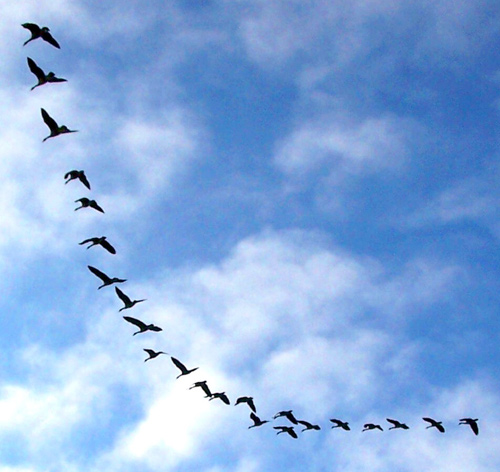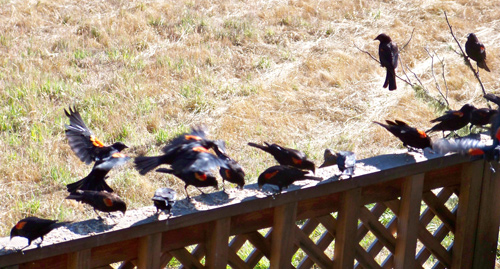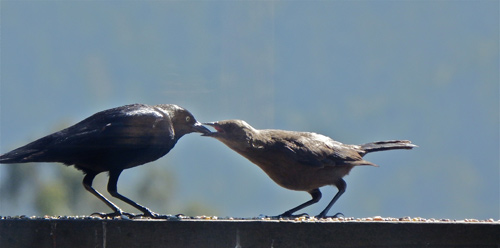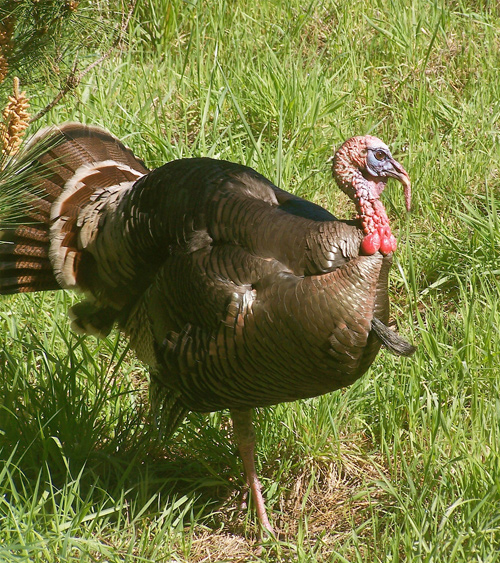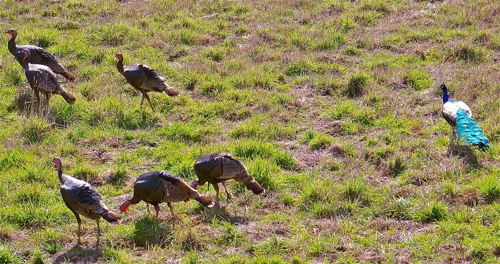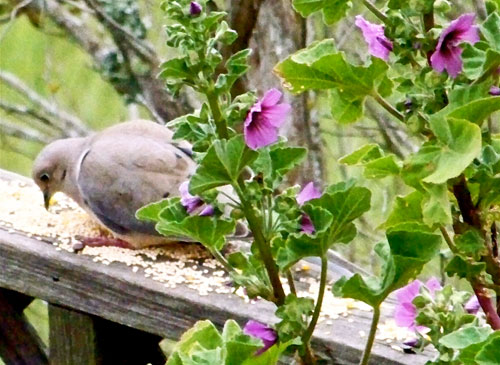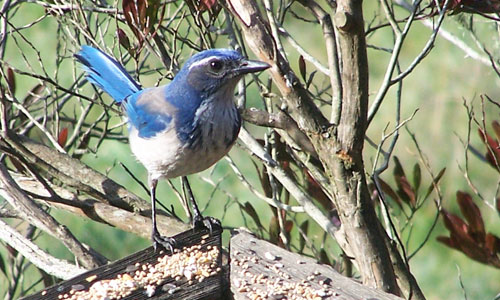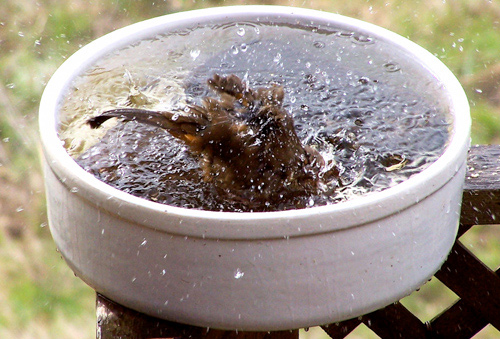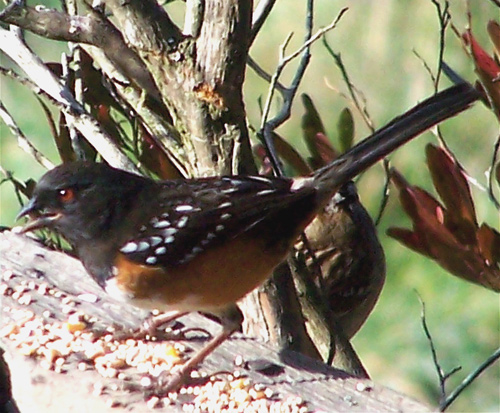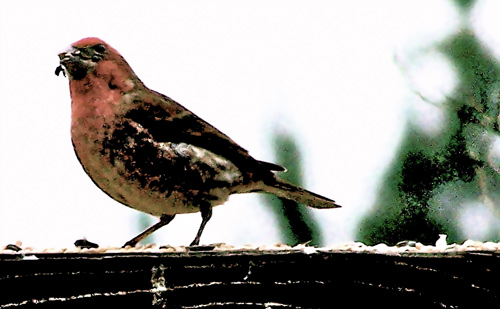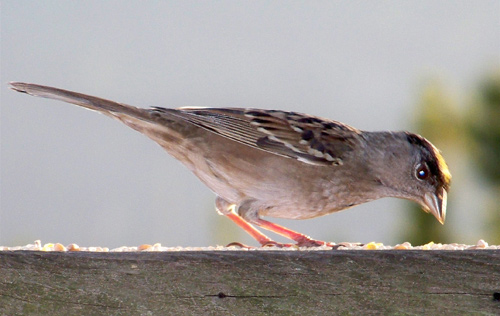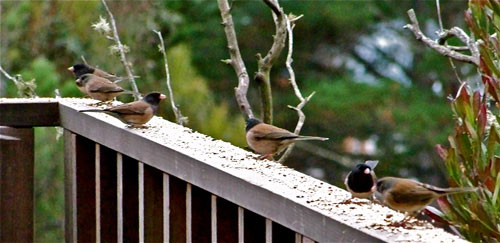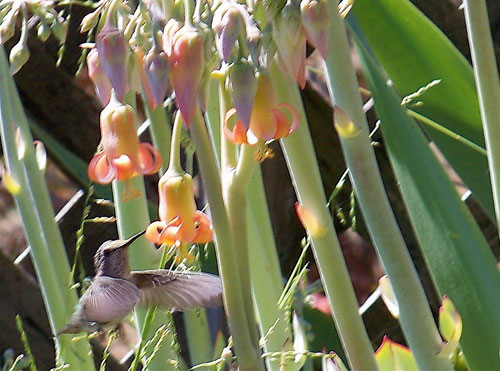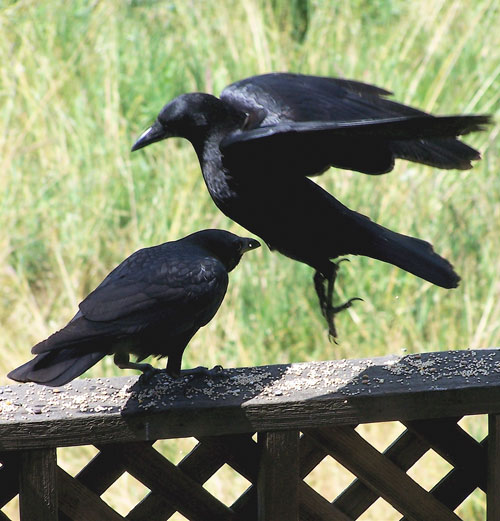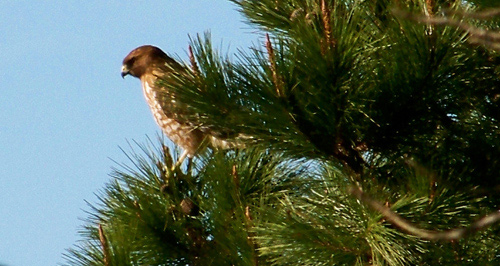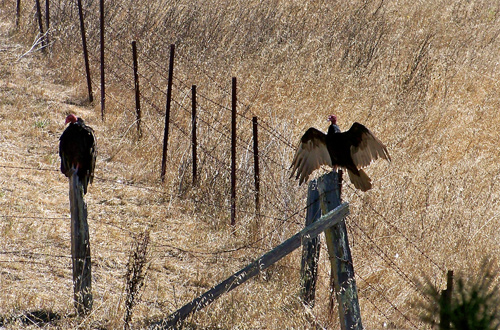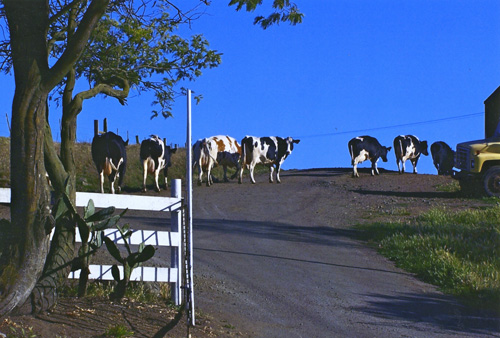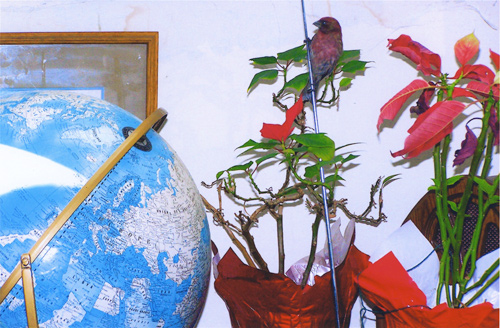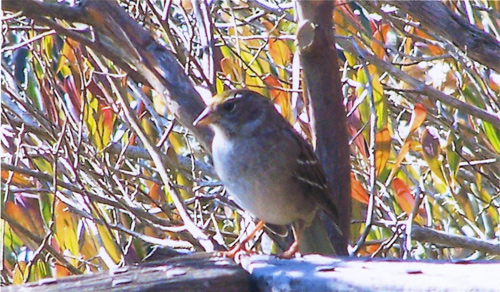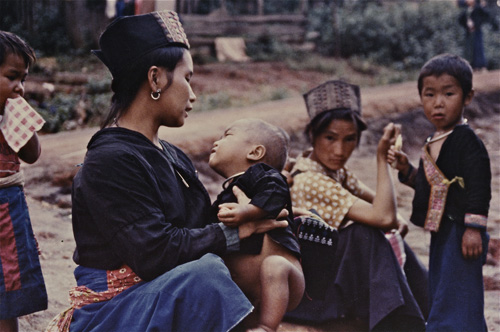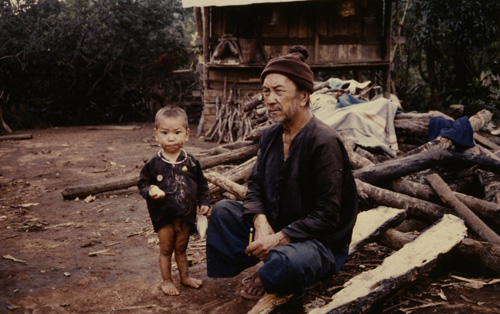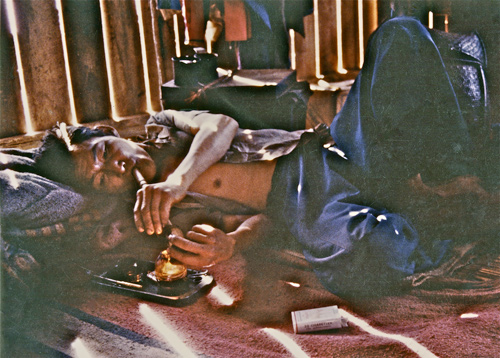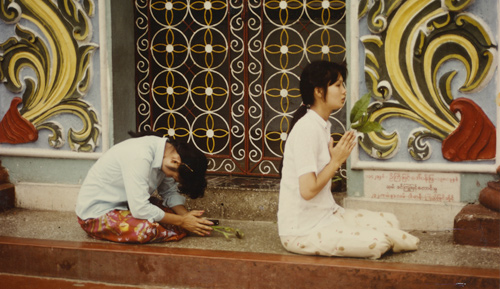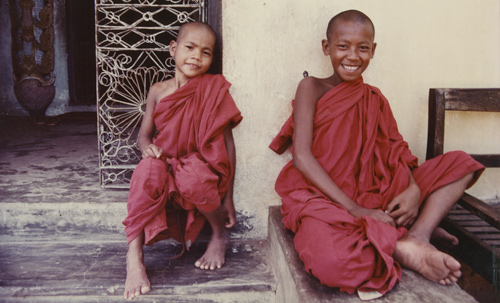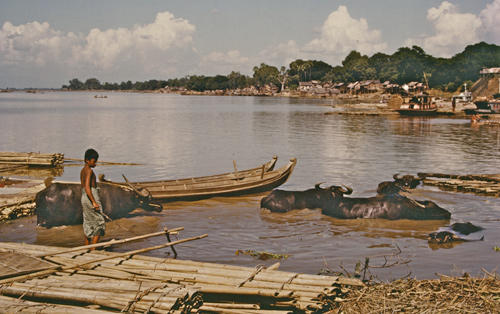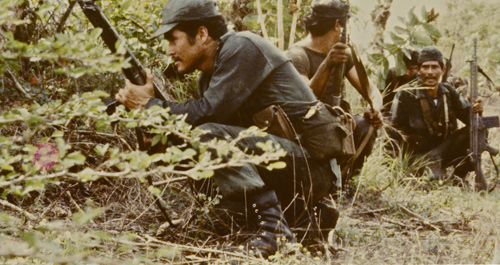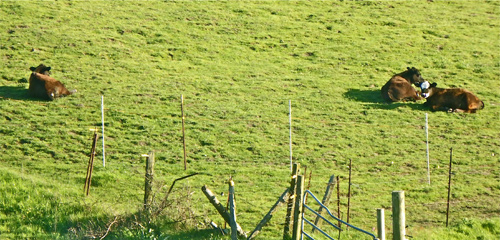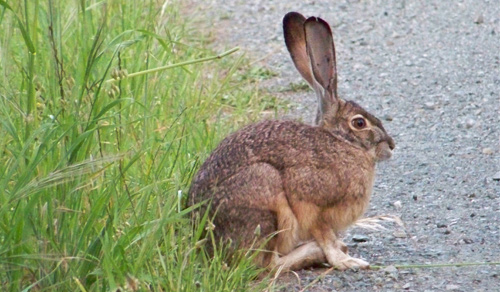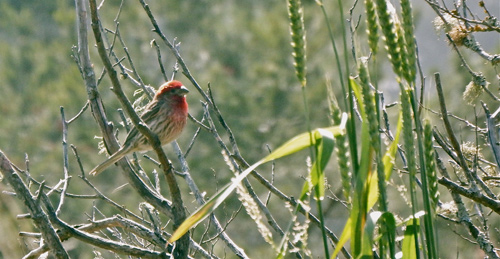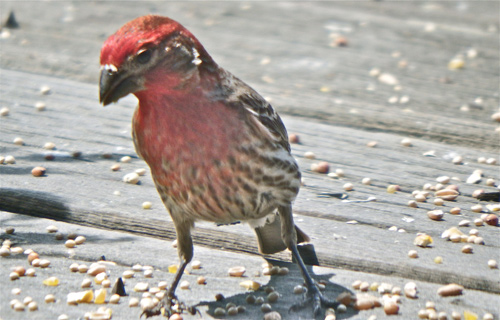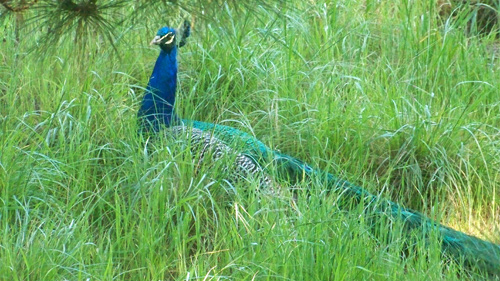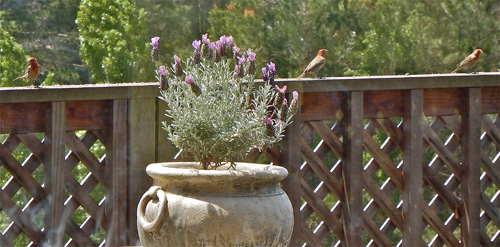Entries tagged with “Golden-crowned sparrow”.
Did you find what you wanted?
Sun 18 Jan 2015
Here is a gallery of my bird photography, as was promised two weeks ago. The photos were all shot at Mitchell cabin or around it.
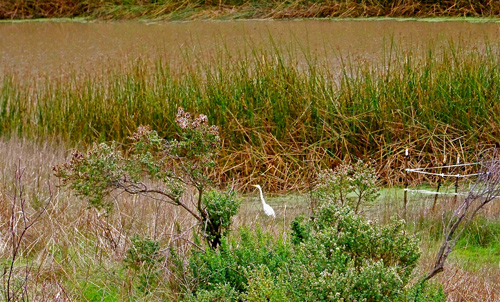
One reason Mitchell cabin gets quite a variety of birds and other wildlife is that its fields come within a few feet of a neighbor’s stockpond, where numerous creatures show up daily to drink or hunt. Here a common egret wades through shallow water, looking for frogs, small fish, or insects.

While it’s hunting, a great blue heron will repeatedly stand motionless and then use lightning-fast strikes with its sharp bill and long neck to catch gophers in Mitchell cabin’s fields or frogs and fish in the pond.

The cabin is under the commute route for Canada geese which travel daily between the Point Reyes National Seashore and the Marin French Cheese Factory’s ponds in Hicks Valley. It’s easy to tell when they’re coming; they honk as much as Homo sapiens commuters stuck in traffic.

A flock of tri-colored blackbirds swoop down onto the deck railing when Lynn or I spread a line of birdseed along it morning and evening. Many of the blackbirds nest in reeds at the pond.

Even after they’ve grown old enough to feed themselves, young blackbirds for awhile still want to be fed by their parents. Once in awhile the parents do oblige them, but over a few days, they wean their youngsters. (Photo by my partner Lynn Axelrod)

A tom turkey struts his stuff. In 1988, a hunting club working with the State Department of Fish and Game introduced non-native turkeys into West Marin on Loma Alta Ridge, which overlooks the San Geronimo Valley. By now there are far more turkeys than turkey hunters, and their flocks have spread throughout West Marin.

A little more than a year ago, a lone peacock showed up and soon began hanging out with a flock of wild turkeys. Months later, he can still be seen bringing up the rear as the flock hunts and pecks its way across the fields.

A male quail. Male and female quail both have crests. The males’ crests are black, the females, brown.

The Eurasian collared dove is a native of the Middle East that spread across Europe in the 20th Century, according to the Audubon Society. In 1974, it was accidentally introduced into the Bahamas. In the 1980s, the doves discovered the US was only a short flight away and began taking trips to Florida. In less than 30 years, the doves have spread throughout most of this country.

California western scrub jays show up immediately when we put seed on the railing.

A California towhee freshens up in the birdbath on the deck.

Rufous-sided towhees are among the most colorful birds that show up for birdseed.

A purple finch chews a sunflower seed it found among other seeds on the railing.

The presence of golden-crowned sparrows is often announced by their song, which sounds like Three Blind Mice in a minor key.

Oregon juncos keep a close eye on Mitchell cabin’s deck, and it’s never long after we put out birdseed that they begin showing up. They’re less skittish than most other birds and will sometimes begin pecking seeds off the railing before we’ve departed.

A female hummingbird. Hummingbirds drop by for drinks whenever we have flowers in bloom.

American crows, which are native to North America, are considered intelligent birds. Here, for example, they demonstrate their mastery of jitterbug.

A crow skins its caterpillar dinner in the birdbath.

Redtailed hawks dine on reptiles, small mammals, and birds. Their call is a two-or-three second scream which trails downward. Redtails are monogamous and typically reach sexual maturity at age two or three and can live to age 21 in the wild.

When I spotted this great-horned owl in a tree 200 feet or more from the cabin one evening, I decided to try photographing it. However, the light was so low that when I triggered the shutter, the little flash on my old-fashioned Kodak flipped open and fired. To my amazement, the flash was reflected in the owl’s eyes despite the bird’s distance from me. With eye shine (see tapetum lucidum) like that, it’s no wonder owls can see well in the dark.

Two buzzards warming themselves in the morning sun.
This gallery doesn’t include all the birdlife around Mitchell cabin, of course, but it’s a sampling of our avian neighbors. They’re not the only reason I enjoy living where I do, but they’re a big part of it.
Tags: American crow, buzzards, California western scrub jay, Canada geese, common egret, Eurasian collared dove, Golden-crowned sparrow, Great blue heron, great-horned owl, purple finch, quail, redtailed hawk, Rufous-sided towhee, towhee, Tricolored Blackbirds, wild turkeys
Sun 11 May 2014
Posted by DavidMitchell under Photography
Comments Off on A few of my photos in war and peace from West Marin to Southeast Asia to Central America
“Every picture tells a story, don’t it?” Rod Stewart

Cows heading toward the milking barn at Steve and Sharon Doughty’s ranch in Point Reyes Station. Of all the photos I’ve shot of West Marin agriculture, this is my favorite (2004).

The newsroom of The Point Reyes Light when the newspaper was located in Point Reyes Station’s Old Creamery Building (2004).
One day I heard something banging around in the firebox of the newsroom’s potbellied stove, which was not lit, so I opened the door to look inside. This house finch, which had apparently fallen down the chimney, flew out and started flying around the room, banging into the closed skylights.
I opened a skylight, but the finch didn’t fly out. Instead it landed on the antenna to our weather radio and perched there looking out over the world. The scene seemed so symbolic he could have been an avian journalist.
Before long a house finch outside the building began singing. The one inside sang back. After several seconds of their calling back and forth, the finch in the newsroom finally flew out the open skylight.

A Golden-crowned sparrow disguised as a stained-glass window, Point Reyes Station (2004).

Scotty’s Castle in Death Valley (2005).
The castle was built in the 1920s by Albert Mussey Johnson, a millionaire from Chicago. Scotty (Walter Scott) was a con man, who took advantage of Johnson, as well as others. Nonetheless, Johnson kept Scotty around to entertain guests with his storytelling.

Thailand (1986).
Two mothers and their children in one of Thailand’s semi-isolated hilltribes.

A Thai hilltribe father and his son (1986).
The father is holding a Point Reyes Light ballpoint pen, which I had given him. The pens were made in 1979 to commemorate the paper’s winning the Pulitzer Prize for Meritorious Public Service.

Thailand’s hilltribes grow opium poppies, as well as bananas and other crops. Here a man in his hut without windows, only gaps between wall boards for light, smokes opium in a pipe (1986).

Rangoon, Burma (1986).
Two Buddhists pray outside the Shwedagon Pagoda. In 1989, the military government changed the country’s name to Myanmar because Burma was the name the British used when the country was their colony. Some citizens, however, question the military’s right to change their country’s name, and many continue to use the name Burma. The name comes from the name of the country’s largest ethnic group, the Bamar.

Mandalay, Burma (1986).
Buddhist monks in Thailand and Burma are considered novices before they turn 20. Most live monastic lives for only short periods, a few years or even just a few days. Youths receive schooling inside or outside of their temple. Helping take care of the temple is one of their main responsibilities. Novices are not expected to be continually solemn, and these boys felt free to roughhouse with each other.

Boy tending water buffalo at the edge of the Irrawaddy River at Mandalay (1986).

Guatemala (1982).
Two Mayan girls wash dishes at a pila (outdoor trough) because their homes on a finca (plantation) lack running water. For many women in rural villages, washing dishes and clothes together at a community pila is their primary time to socialize.

El Salvador (1983).
Government forces take cover during a firefight with FMLN guerrillas. The government patrol, which had been fighting all night, was exhausted and retreating under fire.

Guerrilla-held territory, El Gramal, El Salvador (1983).
A guerrilla stops a vehicle belonging to Antel, the government-owned phone company, and then sends it on its way. Earlier in the day, an Antel driver divulged a bizarre arrangement whereby the guerrillas regularly borrowed the four-wheel-drive Toyota for night patrols but returned it to Antel in the morning. Such cooperation probably explained why an Antel manager in El Gramal said the government phone company in his area was able to operate as usual even though Popular Liberation Front guerrillas had by then occupied the region for six months.
Tags: Albert Mussey Johnson, Antel, Buddhism, Burma, Death Valley, Doughty ranch, El Salvador, finca, Golden-crowned sparrow, Guatemala, House finch, Irrawaddy River, Mandalay, Myanmar, opium, pila, Point Reyes Light, Rangoon, Scotty's Castle, Shwedagon Pagoda, Thailand
Mon 5 May 2014
Posted by DavidMitchell under agriculture, Marin County, Point Reyes Station, West Marin nature, Wildlife
Comments Off on Animals provide relief from an animalistic world
What many of us on the coast like most about West Marin these days is its mix of land and animals, both wild and domestic. They provide a refuge from the violence, hatred, greed, and misfortune that dominate the news coming in from Kabul to Kiev, from Kenya to Korea.

Horses from Point Reyes Arabians stable graze in a pasture next to mine. Downtown Point Reyes Station can be seen through a gap in the trees at right.

The horses drink from, and in warm weather cool off in, this stockpond and another further downhill. Originally created to provide water for cattle, the ponds these days are watering holes for deer, such as these, and other wildlife, along with the horses.

A young buck grazes alone near Mitchell cabin. Most of the year, I can spot blacktail deer around the cabin virtually every day. Herds of 12 and 14 animals are not uncommon. Deer, as most of us know, will eat flowers, vegetables, and shrubbery if given a chance. At Mitchell cabin, any plants I want to protect from deer are grown in containers on my deck. (Photo by Lynn Axelrod)

Three cows laze about Carol Horick’s pasture across the canyon on a warm afternoon last week. (Photo by Lynn Axelrod)

The jackrabbit that has taken to hanging out along my driveway was there every day this past week, usually with a companion. The other rabbit is more skittish, however, and hops away whenever it sees me. As a result, I’ve yet to get a photo of the two of them together.

House finches are year-round residents of West Marin, but they seem more plentiful at this time of year. Their cheerful warbles are as colorful as the males’ feathers. (Photo by Lynn Axelrod)

Male house finches are usually red, with the intensity depending on the season. Their coloration is derived from the fruits and berries in their diets. Female house finches tend to be light brown with white streaks. (Photo by Lynn Axelrod)

When it comes to coloration, however, no other bird around Mitchell cabin can match this lone, male peacock, which for three years has been hanging out with a flock of wild turkeys. Peafowl which originated in India were introduced on the US mainland in California back in 1879.

A golden-crowned sparrow looking for birdseed on my deck. People have compared the bird’s song to Three Blind Mice sung in a minor key. (Photo by Lynn Axelrod)

Although it’s called an Oregon junco, this variation of junco can be found from the Pacific Coast to the Rocky Mountains, as far north as southern Alaska, and, occasionally, as far east as Nebraska, Kansas, Oklahoma, and Texas. Their song is a sweet trill. (Photo by Lynn Axelrod)

We’ll close with three house finches in a classical pose on the railing of my deck. Originally native to Mexico and the southern United States, house finches in the 1940s were introduced on the East Coast where they have rapidly spread. Ornithologists estimate there are now between 267 million and 1.7 billion of them in North America. (Photo by Lynn Axelrod)
Tue 8 Jan 2013
From a butterfly to a pair of badgers, from a newt and a salamander to a bobcat and a coyote, this posting is a collection of some of my favorites from among the photos I’ve taken of wildlife around Mitchell cabin.

A Buckeye butterfly atop a chrysanthemum on my deck.

Closeup of an amphibian, an arboreal salamander.

Lying low, another amphibian.
A Pacific tree frog’s color depends on where it is at the moment. Unlike chameleons, whose colors change to match background colors, tree frogs’ colors change (between brown and green) depending on how dry or moist their surroundings are.

A poisonous amphibian.
The skin of a California newt such as this secretes a neurotoxin, tetrodotoxin, that is hundreds of times more toxic than cyanide.

A macho reptile.
Male Western fence lizards do pushups to intimidate other males. In the process they reveal their blue undersides, which is why they’re sometimes called Blue-bellies.

A colorful but seldom seen reptile.
I found this Pacific ring-necked snake in a rotten log while splitting firewood. The snake eats very small creatures, tadpoles, insects, and especially salamanders. It has just enough venom to immobilize them but is not dangerous to humans.

A beady-eyed garter snake warms itself in the sun on my driveway.
Garter snakes are the most-common genus of reptile in North America. Although they are venomous, their venom is too mild to harm humans. However, when they’re disturbed, garter snakes emit a foul-smelling secretion from a gland near their anus.
Common garter snakes come in innumerable variations and are found in fields, forests and wetlands nationwide. Like this snake, adults average about four feet in length. In West Marin, their diet typically consists of tadpoles, slugs, and earthworms. But unlike other snakes, they don’t eat insects. When first born, the snakes are prey for bullfrogs. Hawks and foxes eat adults.

Gopher snakes are non-venomous although they don’t want you to know it.
“When disturbed, the gopher snake will rise to a striking position, flatten its head into a triangular shape, hiss loudly and shake its tail at the intruder,” the Arizona-Sonora Desert Museum website notes. “These defensive behaviors, along with its body markings, frequently cause the gopher snake to be mistaken for a rattlesnake.”

Golden-crowned sparrow disguised as a stained-glass window.

Heading for a drink at the birdbath on Mitchell cabin’s deck, a crow hops over a second crow, which stays put at their birdseed buffet.

A great blue heron hunting gophers in my field.

Chipmunks visit Mitchell cabin only occasionally, so I felt lucky to snap this photo of one.

A Western gray squirrel as seen from my bedroom window.
Every morning the ground around Mitchell cabin is littered with the freshly cut tips of pine branches because of this squirrel and his clan. Squirrels like to feed on pine trees’ cambium layer, which is immediately under the bark, and in the process they gnaw off twigs.

Trying not to be noticed.
West Marin’s large jackrabbits, which some people call black-tailed hares, are often seen in the late afternoon and evening around Mitchell cabin. To avoid catching the eye of predators, jackrabbits typically sit motionless unless the danger comes too close. Then they suddenly spring away, making sharp, evasive turns as they flee.

A gray fox on Mitchell cabin’s deck.

Young raccoons retreat to a tree when they feel threatened by other animals.

A blacktail doe nurses one of her two fawns.

Relying on its spots for camouflage, a newly born fawn tries to be invisible in tall grass by lying absolutely motionless even though I was leaning over it to take a photo.

A buck and two fawns bounding across tractor-mowed grass.

A mother badger and her cub sun themselves on the mound of dirt around their burrow (known as a “sett”).

A bobcat hunting outside my kitchen window.

A coyote heads for cover in, appropriately enough, a patch of coyote brush.

Besides photographing the wildlife around Mitchell cabin, I also enjoy having a bit of fun with it. My posting about encouraging a bodhisattva possum on her path to spiritual enlightenment has proven to be one of the best-read I’ve ever put online.

I take each species’ disposition into account when determining what it is best suited to learn. Raccoons, as you might guess, are natural bartenders.
 The biggest challenge I’ve faced in training wildlife has been convincing different species to get along with each other.
The biggest challenge I’ve faced in training wildlife has been convincing different species to get along with each other.
I felt a bit like a miracle worker when I finally got a possum, a fox, and a raccoon, none of which traditionally like each other, to dine nose to nose just outside my kitchen door.
I did it by setting out well-separated handfuls of peanuts for them and over time moving the handfuls closer and closer together. Now why can’t diplomats do that in the Middle East?
Tags: arboreal salamander, badgers, blacktail deer, bobcat, Buckeye butterfly, California newt, chipmunk, coyote, crows, garter snake, Golden-crowned sparrow, gopher snake, Great blue heron, grey fox, jackrabbit, Pacific ring-necked snake, Pacific tree frog, possum, raccoons, Western fence lizard, Western gray squirrel



